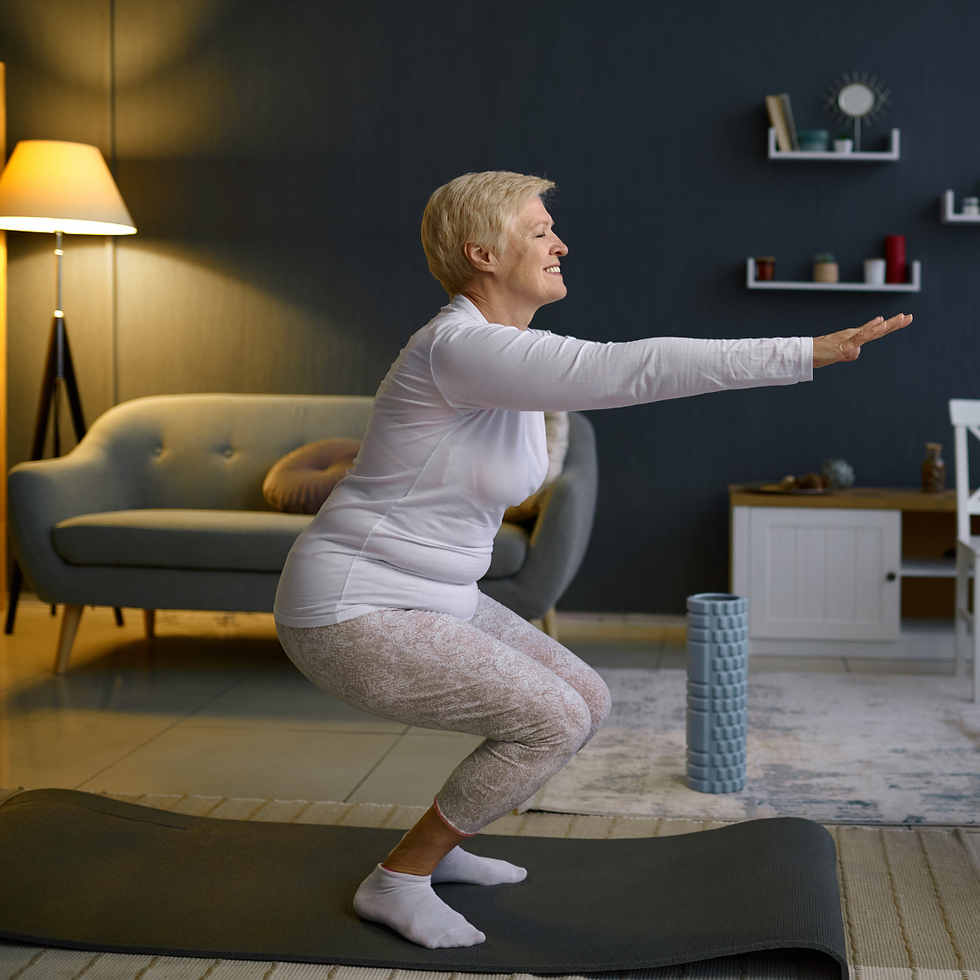How strength training prevents and treats Osteoporosis
- Fiona Kashmer
- May 20
- 3 min read
Updated: May 29
Osteoporosis is a condition characterized by low bone mass and structural deterioration of bone tissue, leading to bone fragility and an increased risk of fractures. In 2021, 20.0% of Irish women and 6.2% of Irish men aged ≥50 years estimated to have osteoporosis (1). This means that women are approximately 3 to 5 times more likely to develop the condition. (2). Strength training, also known as resistance training, plays a key role in both the prevention and management of osteoporosis.
How Strength Training Helps Prevent Osteoporosis
Stimulates bone growth
Strength training helps prevent osteoporosis by stimulating bone growth and improving musculoskeletal health (3). Bones are living tissues that adapt to the forces placed upon them. When muscles contract during resistance exercises, they pull on the bones, creating mechanical stress. This stress signals the body to increase bone formation, particularly through the activation of osteoblasts—cells responsible for building new bone tissue. Higher peak bone mass reduces the risk of developing osteoporosis later in life. For women, who are at greater risk of osteoporosis due to hormonal changes after menopause, building bone strength early is especially critical.
How Strength Training Helps Treat Osteoporosis
Increases Bone Mineral Density
For individuals already diagnosed with osteoporosis, strength training offers significant benefits in slowing or even partially reversing the progression of the disease. Although it cannot completely cure osteoporosis, strength training has been shown to maintain or increase bone mineral density (BMD), particularly in areas most prone to fractures such as the hips, spine, and wrists (5).Resistance training helps to counteract the natural bone loss that occurs with age, particularly in postmenopausal women. In some studies, strength training has been more effective than aerobic exercise in improving BMD. The mechanical loading of bones during resistance training provides a stimulus for the body to retain or build bone tissue, even in older adults.
Supports bones and joints
Strength training also strengthens the muscles surrounding bones and joints, offering additional support and protection. For example, stronger back muscles can reduce the risk of spinal fractures and improve posture, which often deteriorates in osteoporotic patients. Furthermore, improved postural control and proprioception (the body’s sense of position in space) reduce the risk of falls, further decreasing the likelihood of fractures (4).
Decreases risk of falls
Beyond bone health, strength training also enhances muscle strength, balance, and coordination, all of which contribute to a reduced risk of falls. Since falls are a major cause of osteoporotic fractures, especially in older adults, improving physical stability is a key preventive measure (4).
Ready to experience the power of strength training for yourself?
Whether you're new to it or looking to level up your routine, we're here to help you feel stronger, more energised, and more confident in everyday life.
Sign up now for a FREE virtual strength training session.
Come see how the right training can change not just your body, but your entire day with just two 30 minute sessions a week.
BOOK NOW — spaces are limited, so grab yours today!
References
(2) Kanis, J. Assessment of osteoporosis at the primary health-care level. WHO Scientific Group Technical Report. 2007 [Accessed 22.02.2019];
(3) Watson SL, Weeks BK, Weis LJ, Harding AT, Horan SA, Beck BR. High-Intensity Resistance and Impact Training Improves Bone Mineral Density and Physical Function in Postmenopausal Women With Osteopenia and Osteoporosis: The LIFTMOR Randomized Controlled Trial. J Bone Miner Res. 2018 Feb;33(2):211-220. doi: 10.1002/jbmr.3284. Epub 2017 Oct 4. Erratum in: J Bone Miner Res. 2019 Mar;34(3):572. doi: 10.1002/jbmr.3659. PMID: 28975661.
(4) Stanghelle B, Bentzen H, Giangregorio L, Pripp AH, Skelton DA, Bergland A. Effects of a resistance and balance exercise programme on physical fitness, health-related quality of life and fear of falling in older women with osteoporosis and vertebral fracture: a randomized controlled trial. Osteoporos Int. 2020 Jun;31(6):1069-1078. doi: 10.1007/s00198-019-05256-4. Epub 2020 Jan 10. Erratum in: Osteoporos Int. 2020 Jun;31(6):1187. doi: 10.1007/s00198-020-05398-w. PMID: 31925473.
(5) Linhares DG, Borba-Pinheiro CJ, Castro JBP, Santos AOBD, Santos LLD, Cordeiro LS, Drigo AJ, Nunes RAM, Vale RGS. Effects of Multicomponent Exercise Training on the Health of Older Women with Osteoporosis: A Systematic Review and Meta-Analysis. Int J Environ Res Public Health. 2022 Oct 30;19(21):14195. doi: 10.3390/ijerph192114195. PMID: 36361073; PMCID: PMC9655411.


Comments